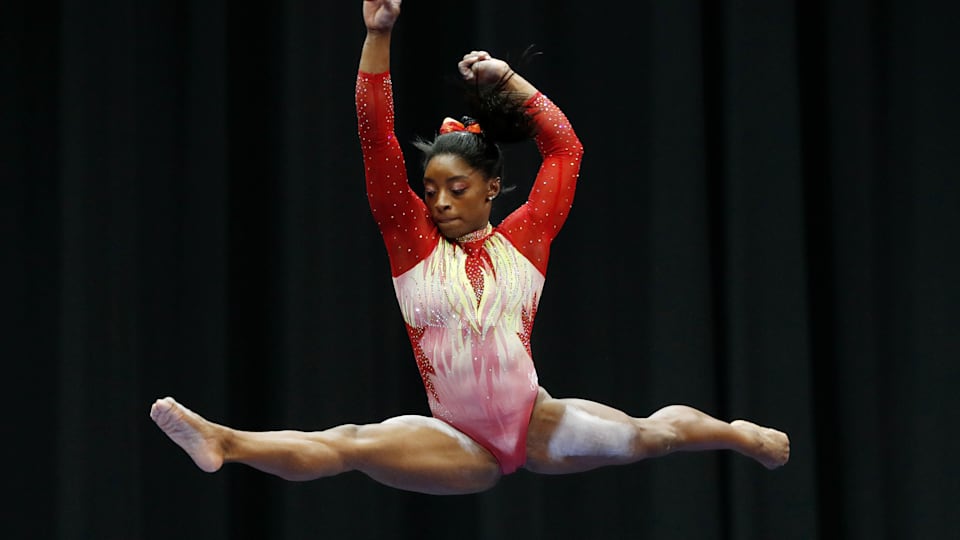Simone Biles: Is the best still to come?
How to assess the four-time Olympic champion's return to action

If there were doubts about the Simone Biles comeback, they’ve been silenced. Despite a slip on the uneven bars, the four-time Olympic gold medalist easily won the all-around and three events at last weekend’s U.S. Classic in Columbus, Ohio.
With the U.S. Championships just two weeks away in Boston, Biles looks poised for more success and add further weight to the argument that she is the greatest gymnast of all time.
So just how good was Biles on her comeback? And where does she go from here?
Biles Boosted By Difficulty Score
In 2006, the International Gymnastics Federation (FIG) got rid of the 10.0 scoring system, introducing a new method based off two numbers: the difficulty score (d-score), which starts from zero and increases as the gymnast performs his or her routine, and the execution score (e-score), which starts from 10.0 before judges take deductions for errors.
In Columbus, Biles received d-scores of:
- 6.000, vault;
- 6.100, uneven bars;
- 6.300 balance beam;
- 6.600 floor exercise.
She had the highest values on every event, except the uneven bars where Alyona Shchennikova edged her out by a tenth of a point.
Combined her d-score was 25.000, more than two points higher than second-place finisher Riley McCusker’s 22.500.
Biles is likely to enjoy this advantage even as she heads to the World Championships in October.
In last year’s World all-around final, the highest total d-score was just 22.300 (Japan’s Mai Murakami).
Not as easy as she makes it look
Before Gabby Douglas and Aly Raisman made back-to-back U.S. Olympic teams in 2012 and 2016, there had not been a repeat Olympic appearance for U.S. female gymnast since Dominique Dawes competed in her third-straight Games in 2000.
Both Douglas and Raisman took about nine months longer than Biles to return to competition after Olympic glory in London, and Douglas was the first reigning Olympic all-around champion to return to the Games since the legendary Nadia Comaneci in 1976 and 1980.
The fact that Biles has not only returned to competition so quickly but also appears to (barring injury) already be locked-in for the 2020 Olympic team is beyond remarkable.
It’s difficult to see how anyone will catch her between now and July 30, 2020, when the women’s all-around medals are handed out in Tokyo.
Winning back-to-back titles hasn’t happened since Czechoslovakia’s Vera Caslavska won in 1964 and 1968.
A chance for more history
In the buildup to Rio, Biles faced questions from media about achieving history and setting records.
Could she become the first woman to win three consecutive World titles? Could she win her fourth-straight U.S. title? Could she win four – maybe even five – Olympic gold medals?
With all of those checked off, the 21-year-old has a chance to cement herself as the greatest gymnast of all time (a term she shrugged off in an interview last week with Olympic Channel).
Currently, Biles ranks third all-time for World Championships medals with 14. She accomplished that haul in just three trips to the Worlds.
With potential for five more medals later this year at the World Championships in Doha, Qatar, Biles could be within one medal of all-time leader Svetlana Khorkina, who won 20 medals in eight appearances at Worlds.
In Rio, Biles claimed four gold medals and one bronze, tying the record for most golds at a single Games with Larissa Latynina (1956), Caslavska (1968) and Ekaterina Szabo (1984).
Inevitably, Biles will face questions about bettering this result in Tokyo – a feat she was just one skill away from in Rio.
If Biles were to win five gold medals in Tokyo, she would tie Latynina, who competed in three Games, for most Olympic gymnastics gold medals at nine.
A repeat five-medal performance would rank her third all-time in women’s gymnastics medals with Hungary’s Agnes Keleti (1952, '56) and the Soviet Union’s Polina Astakhova (1956, '60 and '64).
The best is yet to come?
All eyes were on Biles in Columbus.
In training, her best turns received applause and gasps from judges, fellow gymnasts, coaches and media.
From the moment the doors opened to the public Saturday night, little girls yelled her name and waved every time she made a move.
Expectations were soaring as high as Biles’ trademark tumbling.
The pressure to be the perfect gymnast that captured four golds in Rio was palpable.
At the start, it looked like the adrenaline of the moment was getting the better of Biles. She over rotated a layout double-double in her opening floor tumbling pass, something almost no one else can do, and struggled to control her power again on vault.
A mistake on the uneven bars or balance beam seemed almost inevitable.
She missed a release move, her Tkatchev, in the one-touch warmup just prior to competition.
When she missed her pirouette in competition, the pressure to be perfect was instantly broken, and she could compete full out on the balance beam. Which she did.
Now that the first meet nerves have been shook off, expect to see something even better in Boston.
Team USA's women are still really good
It’s easy to look at the gap (which will likely widen in Boston) between first and second place and lose sight of just how good the U.S. women still are.
The chasm between Biles and McCusker has more to do with Biles’ brilliance than any deficiency on Riley McCusker's part.
McCusker’s 57.500 is the third highest all-around total in 2018, according to the gymnastics blog thegymter.net.
Add in World champion Morgan Hurd’s 56.599 total from earlier this year at the American Cup, and it becomes apparent that the U.S. women are poised to continue their dominance.
Team USA have collected three straight World Team titles (2011, 2014, 2015) and back-to-back Olympic titles, having not lost a major team title since winning the 2011 World Championships in Tokyo.
